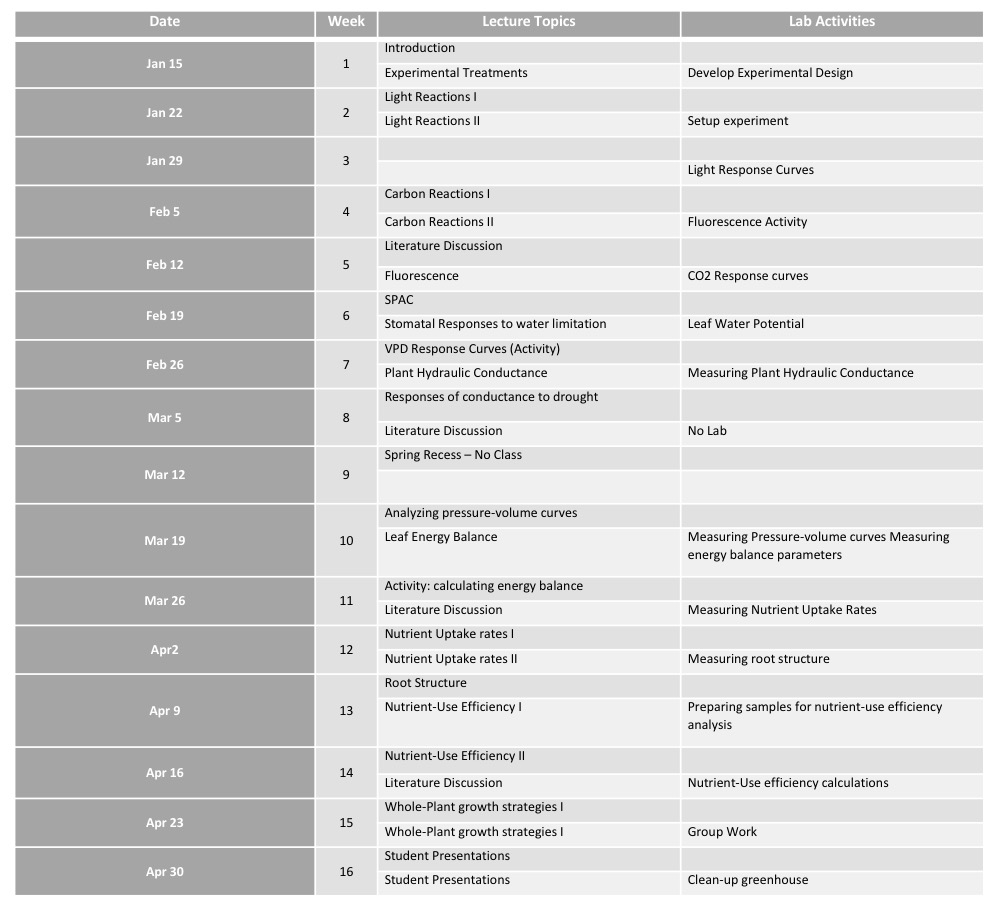F510 – Ecophysiology of Trees
Syllabus & Schedule
Spring 2018
Course Description
This course was designed to help graduate students develop both a conceptual and practical understanding of how plants respond to their environment. This course involves a lecture/discussion format in order to introduce concepts to students (Lecture) and then provide an opportunity for students to gain confidence in using the terminology and discussing the implications to their field and beyond through discussions. The lab section of the course will introduce students to some of the instruments commonly used in ecophysiology research and give them an opportunity to use as much of the instrumentation and analyze the resulting data. We will often carry out numerical exercises to increase the students’ ability to interpret the meaning of data and how it can lead to ecological patterns and processes seen in the field. This course will take a carbon-based approach to ecophysiology, as carbon represents the commodity of the transfer of energy for the plant. Within this framework we will cover the following concepts: Photosynthesis, water uptake and use, respiration, translocation, nutrient uptake and use, seed production/germination, whole-plant growth responses, biomass allocation, age-related growth decline, and global perspectives. Throughout the course we will highlight the special for different functional groups, for example: we will discuss the implications of height on tree growth, the impact of C3/C4 photosynthesis in grassland and desert communities, or the investment in deep roots of shrubs. We will discuss how those factors lead to different growth strategies between woody-species and herbaceous plants as they relate to different topics throughout the semester. However, this class is intended to cover basic ecophysiological concepts that relate to all growth forms, so students interested in ecosystems from grasslands forests will find relevant and engaging topics throughout the semester.
Course Goals
To convert you all to ecophysiologists! Ultimately, my goal is to help you become familiar with the basic concepts and techniques that are fundamental to ecophsyiology so that you can better understand the mechanics of plant responses to their environment.
Specific Learning Objectives
When finished with this course, students should have mastered the following concepts and skills:
- Describe, measure, and quantify the key processes involved in photosynthesis and how they respond to environmental conditions.
- Describe the mechanisms involved in the movement of water through plants, including the soil moisture and atmospheric conditions that affect water movement.
- Measure key water-relations parameters that can be used to calculate plant water use and survival under different soil moisture conditions
- Calculate the leaf energy balance under different environmental conditions
- Describe the major processes involved in nutrient uptake, including the different forms of nutrients used by plants
- Calculate plant nutrient-use efficiency and evaluate the ecological implications of different strategies.
- Integrate the above concepts to evaluate the ecological implications of different plant growth strategies. Course Outline and Schedule
Schedule of Topics
Here are the topics that we will be covering in this course and a tentative schedule. The schedule is likely to shift some during the semester except for the exam dates, the exams will occur on the dates listed.
